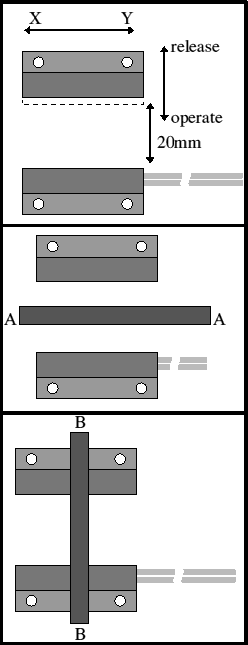

A reed switch is a switch which is operated by a magnetic field. Two fine contacts are contained within a glass tube and spaced so that there is only a very small gap between them. The arrangement is shown in the diagram.
![]()
The contacts are made of a magnetic material so when the switch is in a magnetic field the two contacts start to attract each other and, at a certain field intensity, they snap together, closing the circuit. The field can either be produced by current flowing in a coil (when the device is called a reed relay) or it can be produced by a permanent magnet which is approaching the switch: it must approach to a certain distance before the contacts close and they will stay closed if the magnet gets closer but, as the magnet moves away again, the contacts will stay closed until the magnet has moved further away than the operating distance: there is 'hysteresis'.
 Always operate the reed by moving the magnet towards the reed as shown (top left): if you operate by sliding the magnet past the reed (in the X-Y direction) you will get two or even three operations as the magnet passes the reed.
Always operate the reed by moving the magnet towards the reed as shown (top left): if you operate by sliding the magnet past the reed (in the X-Y direction) you will get two or even three operations as the magnet passes the reed.
Typical operating distance of the reed switches supplied by 4QD is 20mm, with about 2mm hysteresis. If the magnet is fixed between the operate and release points then the reed will 'remember' its last state.
The switch is operated by any change in magnetic field: if the magnet is fixed closer than the operate point, the switch will close. Now if a piece of steel is placed between reed and magnet (A-A in the centre left diagram) it will shield the reed from the magnet and the reed will open.
Similarly if the reed is fixed outside the operating range a piece of steel approaching it (as B-B, lower left diagram) will increase the field and the switch will close.
If the reed and magnet are fixed between the operate and release points, the switch will be toggled closed by B-B and open by A-A.
You can also bias the reed closed with one magnet, placed just inside the operating distance. Now a second magnet may be used to open the reed by cancelling the field of the first magnet.
Reed switches are very versatile. Since the movement of the reeds is very small, they are also very reliable and will last for hundreds of thousands (or even millions) of operations if used correctly. They are however only useful for very small currents so they are ideal for reversing switches for our controllers or for collision detection.
Reed switches have acquired a bad name in the past. The main reason for this is mis-use. The reed contact is tiny and any high current through is causes an arc which welds the contacts. Even if the circuit which senses the reed operates at low current, trouble can be caused if the wiring to the reed is long and the reed operating voltage is high: the wiring's capacitance can then store a small charge which discharges through the reed when it is closes. This charge may cause a high enough current to cause an arc. The cure for this is to fit a resistor in the wiring, in series with the reed switch and close to it to limit any discharge current.
How about using a magnet on the gear lever of a child's car. Move the lever forward and the magnet should move forward, away from the switch, opening it as in the diagram. It should be easy enough to extend a bar from the lever, through the car, touching the bumpers. Now if the front bumper touches anything it will throw the lever into the reverse position whilst a collision on the rear bumper will put the car into forward gear.
Reed switches are used on the electromagnetic cat doors that are available.